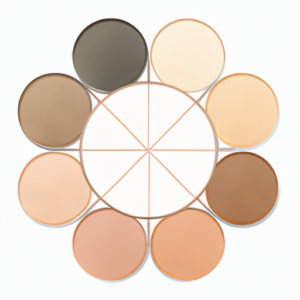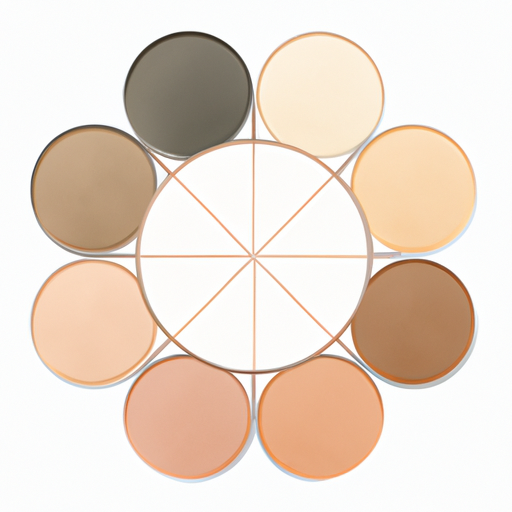What in the World is Bronzer and Contour?
Hey guys, let’s dive into the world of makeup together – starting with bronzer and contour! These may seem like foreign concepts to some, but they’re actually pretty simple. Bronzer is a powder or cream that adds warmth to the complexion, while contour is a product that creates dimension and helps sculpt the face.
Advantages of Using the Same Shade for Bronzer and Contour (and Why I Swear By It)
Let me tell you, using the same shade for bronzer and contour has been a game-changer for me. Here are a few reasons why:
First of all, it’s so much easier to achieve a natural-looking complexion. When I use different shades for bronzer and contour, I run the risk of looking like I have too many products on my face. But when I use the same shade for both, it looks like my skin just naturally has those subtle shadows and highlights. Plus, it’s a time saver! I don’t have to spend as much time blending different shades in, which is always a plus.
Another big advantage is that it saves me money. When I’m using different shades for bronzer and contour, I feel like I have to buy two separate products. But when I’m using the same shade for both, I can just buy one and use it for both purposes. That’s a big plus!
Now, there are some potential drawbacks to using the same shade for bronzer and contour, so it’s not a one-size-fits-all solution. If you’re not careful, you can end up with a muddy or overly tanned look. And if you’re not careful with application, you might end up looking too flat or one-dimensional. But with a little practice and the right technique, these issues can be easily avoided.

Overall, I’m a huge fan of using the same shade for bronzer and contour. To choose the right shade, I recommend considering your skin tone, and picking a shade that is slightly lighter than your foundation. If you do it right, it can be an amazing way to simplify your makeup routine while still looking gorgeous!
Why Using the Same Shade for Bronzer and Contour May Not be a Good Idea
Hey, I get it! With all the beauty products out there, it’s tempting to multitask and use one product for multiple purposes. But using the same shade for bronzer and contour can have its downsides. Here are some reasons why:
Muddy or Overly Tanned Look
If you’re not careful, using a single product for bronzing and contouring can result in a muddy, unnatural look. When you use one shade for both, it can be difficult to blend properly and create a natural-looking gradient. Applying too much bronzer on top of contour can make you look overly tanned and patchy. Trust me, you don’t want to end up looking like you just got back from a week-long beach holiday in a single swipe!
Flat or One-Dimensional Look
Using the same shade for bronzer and contour can also make your face look flat or one-dimensional. Contouring, after all, is all about creating shadows and dimension on the face. A bronzer is meant to add depth and warmth to the complexion. When you use only one shade for both purposes, you risk losing that dimensionality. Your face may end up looking flat and lacking definition.
While using the same shade for bronzer and contour can be a tempting shortcut, it’s important to weigh the pros and cons. To create a more natural and defined look, try using separate shades for bronzer and contour. This will allow you to highlight your features and contour your face to perfection. After all, the goal of makeup is to enhance your natural beauty, not to obscure it!
How to Choose the Right Shade for Bronzer and Contour
When it comes to achieving a flawless, contoured look, choosing the right shade for your bronzer and contour is crucial. If you want to use the same shade for both, there are a few things to keep in mind.
First, consider your skin tone. If you have fair skin, you should opt for a shade that is just one or two shades darker than your foundation. If you have medium to dark skin, you can go a bit darker, but still avoid anything too orange or overly tanned-looking.
Secondly, pick a shade that is slightly lighter than your foundation. This will help give you a natural-looking contour and prevent it from looking too flat or one-dimensional. If you go too dark, you risk looking muddy or like you’re wearing a mask.
Remember, it’s always better to start with a lighter shade and build up as needed. And don’t be afraid to ask for help from a makeup artist or consultant if you’re unsure about which shade will work best for you.
Bottom line: Find your perfect shade for bronzer and contour
As someone who loves makeup, I understand the struggle of finding the right shade for bronzer and contour. After trying both separately and together, here’s what I’ve learned.
Using the same shade for both bronzer and contour is tempting, but it can make you look too muddy or overly tanned. Plus, the outcome may be too flat or one-dimensional, rather than giving dimension to your face. So, it’s essential to choose the appropriate product and shade for each step in your makeup application process.
The benefits of finding the correct shade include a natural-looking complexion, as well as saving both time and money. And trust me, there is nothing better than nailing the perfect look on the first try. To find the ideal shade for your skin tone, consider trying shades that are slightly lighter than your foundation. This way, you can avoid looking too harsh or fake.
Whether you’re a makeup novice or an expert in the field, finding the right shade for bronzer and contour can enhance your features and help you feel more confident in your skin. Experiment with different products, get advice from beauty professionals, and most importantly, have fun with it!
FAQs About Bronzer Contour
Should contour be lighter or darker than bronzer?
Honestly, it’s a matter of personal preference when it comes to matching the shade of your bronzer and contour. Some people like to use one product for both purposes, while others like to differentiate them by using different shades. In my experience and from what I’ve learned, contour is typically a few shades darker than your natural skin tone and is used to create depth and definition on the face. On the other hand, bronzer is used to add warmth and a sun-kissed glow to the skin. It’s usually a shade or two deeper than your skin tone and has a warm undertone.If you’re unsure which shades to use for contour and bronzer, it’s best to experiment and try out different shades until you find what works best for your skin tone and desired look. You may also want to consider the formula and finish of the products you’re using, as they can also affect the overall look.In the end, it’s all about finding what works for you and what makes you feel confident and beautiful in your own skin. Just remember to blend everything out well to avoid any harsh lines or unnatural-looking contour and bronzer.
What color should contour and bronzer be?
Well, personally, I think that bronzer and contour should not be the same shade. Bronzer is meant to give a sun-kissed glow to your skin, while contour is meant to add depth and dimension to your features. Therefore, the two should serve different purposes and have different colors.For bronzer, it’s best to pick a shade that is one or two shades darker than your natural skin tone. This will give you a natural-looking tan without appearing too orange or fake. It’s important to choose a bronzer with warm undertones to mimic the natural warmth of the sun.On the other hand, contour should be a cooler-toned shade that creates shadows and highlights on the face to sculpt and define your features. A rule of thumb is to choose a shade that is two to three shades darker than your natural skin tone. You can use a matte brown or grey contour powder, or even a cream product, to achieve a chiseled effect.In conclusion, while both bronzer and contour serve similar purposes in terms of giving your face a more defined shape, they should have different shades to achieve their desired effects. So next time you’re doing your makeup, make sure to choose a bronzer and contour that complement each other but aren’t the same shade. Happy contouring!
Should contour and bronzer be the same color?
Well, honey, the answer to that question ain’t no simple yes or no. It really depends on what you’re trying to achieve with your makeup. See, bronzer is typically used to give your skin a sun-kissed glow, while contour is used to enhance your bone structure and create shadows. So, if you’re looking for a natural and subtle look, it’s best to keep your bronzer and contour in the same shade family. This will create a cohesive and blended look that won’t be too harsh on your features. But, if you’re going for a more dramatic look, you can definitely mix up the shades and play around with different tones to create a more sculpted effect. Just make sure to blend, blend, blend, so you don’t end up with any harsh lines or patches.Now, if you’re really an expert in makeup, you might even know that different skin tones require different shades of bronzer and contour. See, for fair skin, it’s best to stick to cooler, taupe-toned contour shades to avoid looking too muddy or orange. And for darker skin tones, warmer and richer shades work best to create a more defined look. When it comes to bronzer, it’s important to take into account your undertones as well. Those with cool undertones should stick to cooler bronzers, while those with warm undertones can rock warmer and more golden shades.At the end of the day, the most important thing is to have fun with your makeup and experiment to find what works best for you and your unique features. Just remember, a little blending can go a long way, and don’t be afraid to mix it up and try new things. Who knows, you just might discover your new favorite look!
